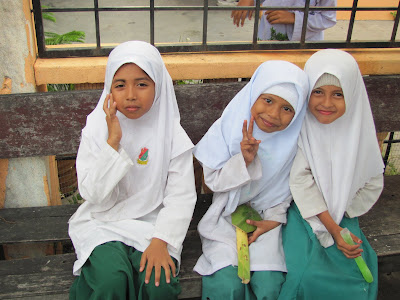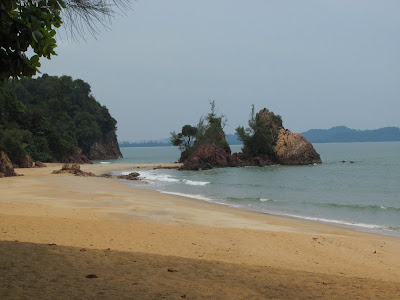The New Straits Times is one of the two main English newspapers in Malaysia. Here is an article written by Sharifa Arfah entitled "Visiting Scholar: Great Malaysian Adventure". Thanks for the great article Arfah!
American biological scientist Associate Professor Mark McGinley has had plenty of ‘true National Geographic’ moments in the short time that he has spent in Malaysia. He tells SHARIFAH ARFAH why he finds the megafauna in the rainforests of Malaysia sexy.
WHEN American Associate Professor Mark McGinley travels, it is the biological diversity of the country which he visits that fascinates him. As far as the lecturer at Texas Tech University (TTU) in Lubbock, Texas, the United States is concerned, Malaysia is a haven for wildlife. “Malaysia is lucky to have a number of ‘sexy megafauna such as Asian elephants, tigers, Sumatran rhinos, Orang-utans and interesting plants such as the Rafflesia and the rainforest epiphytes’. “In addition, it is home to a number of equally interesting but less easily observed organisms such as the rainforest bats and frogs. The underwater diversity is just as great,” says McGinley, who is from TTU’s Department of Biological Sciences.
McGinley is currently on sabbatical leave and is a Fulbright Visiting Scholar at the Institute of Biological Sciences at University of Malaya (UM) in Kuala Lumpur. McGinley teaches a programme on Special Topics in Ecology and Biodiversity at UM as part of his stint in Malaysia. “The purpose of this course is to compare ecology and biodiversity in the US with those of Malaysia. Hopefully, both the students and I would be able to learn a lot by taking this approach,” he adds.
As he teaches only once a week, McGinley spends most of his time compiling materials of local biodiversity for The Encyclopedia of Earth (EoE) (http://www.eoearth.org/), a free electronic reference about the Earth, its natural environments and their interaction with society. “It has a North American focus right now as most of the people involved with the EoE live in the United States and Canada. The goal of the EoE is to be international in scope. We have initiated collections focused on Africa, Latin America and the Caribbean. The Malaysia Collection will be the first collection focused on a single nation,” says McGinley, who is an associate editor of the encyclopaedia.
He hopes the Malaysian Collection he is compiling will trigger “collaborations with local scholars to get them to share their knowledge of the ecology, biodiversity and environmental issues of Malaysia”. “I would also like to get Malaysian scientists involved with the EoE as Topic Editors so that the collection will continue to grow after I leave," says McGinley. To this end, he intends to spend more time travelling “to meet with scientists at other universities and non-governmental organisations (NGOs) and eventually with scholars outside of this region” to explore Malaysian biological diversity.
McGinley had his first taste of Malaysian biodiversity earlier this year when he followed colleague Assistant Professor Tigga Kingston and her students to Krau Wildlife Reserve in Pahang to study the bat population. “We received a grant from TTU which enabled me to spend two weeks at Krau to observe Kingston and her team in their bat research (named The Malaysian Bat Education Adventure). “That was the first time that I have ever visited a rainforest and spent the night (as most of the bat work is done at night),” says McGinley, who finds the idea of sharing the reserve with tigers and elephants thrilling.
Although he did not see any tigers or elephants in the wild, McGinley had plenty of “true National Geographic” moments in the short time that he had spent in Malaysia.
“When we were staying at Pulau Tenggol, Terengganu, a sea turtle came on shore to lay its eggs. On our trip back from the island, we stopped for lunch (somewhere in Terengganu) and saw eight river otters frolicking in the river next to our spot. I have only ever seen one river otter during my entire life in the US,” he says.
Visiting Zoo Negara also allowed him to see “species that I have never seen before”.
Being surrounded by nature certainly brings sweet childhood memories for McGinley. Family vacations as a child were spent camping and fishing, bringing him closer to the natural world, he recalls. “My two favourite television shows when I was a kid were Wild Kingdom and The Undersea World of Jacques Cousteau, and I loved learning about the interesting animals and plants that were found all over the world,” says McGinley.
At age 11, when McGinley’s father was transferred from Texas to Australia for work, he was exposed to kangaroos, koala bears, emus, kookaburras and lorikeets, among others. “From then on, I always knew I would become a biologist when I grow up,” he says.
He hopes to trigger a passion for biodiversity to the public, especially among youth. The Malaysian Bat Education Adventure is one of McGinley’s attempts at developing a fun way for youngsters to learn Science. “Dr Kingston, a few colleagues and I came up with the idea to use the biology of Malaysian bats as the focus of a science curriculum for elementary and middle-school children in Texas. Modern communication technology had made it possible for students in Texas to follow the research via a website (http://www.ttu-mbea.org/). “In addition, Dr Kingston was able to communicate with students live via satellite to tell them about the study,” he adds.
McGinley aims to identify Malaysian schools that are interested in the project before he completes his stint at UM “so that local youth could also be involved”.
He feels it is his duty to spread the wonders of Malaysian biodiversity with not only potential foreign visitors but also the Malaysian public as there are not many experts in the field, particularly among locals.
“I have done a fair amount of research on ecology and biodiversity in Malaysia before I arrived and I find that I know a lot more about the incredibly interesting species that are living in the country than do many Malaysians.”
He finds it heartening to see plenty of media attention on environmental issues.
“There are articles about the environment in the newspapers almost every day, which is quite different from the local paper back home. There are also lots of discussions on ‘green technology’, which is encouraging. I hope that ‘going green’ truly becomes a way of life and not just an advertising slogan.
“I appreciate the effort by the media, NGOs and educators to share as much information about Malaysian biodiversity with the public. I hope that Malaysians know how lucky they really are!” he says.
Between teaching a course at UM, compiling data for the Malaysia Collection and finding local schools to participate in the bat study, it seems that McGinley has a lot on his plate.
But McGinley has not neglected to pencil in some time to explore the rich biodiversity of Malaysia for pleasure. “I look forward to visiting Malaysian islands such as Langkawi and the national parks. I am excited to visit East Malaysia. I hope to spend time in both Sarawak and Sabah. I want to hike in the rainforest, climb Mt. Kinabalu and dive in Sipadan,” says McGinley, who is known to spend part of his summer teaching scuba and marine biology on a sailboat in the Caribbean Sea.
http://www.nst.com.my/nst/articles/Visitingscholar_GreatMalaysianadventure/Article/





















































